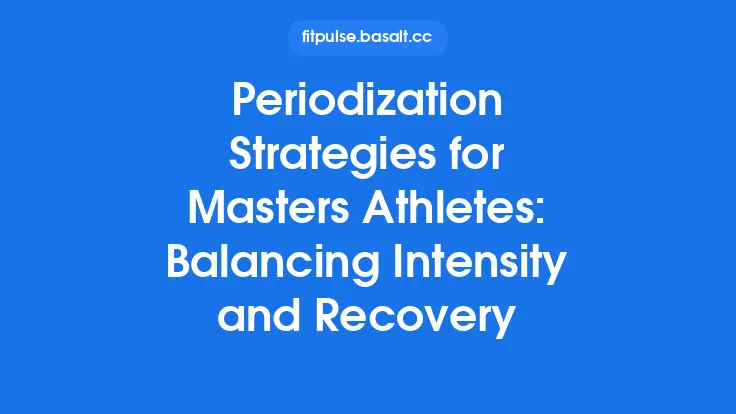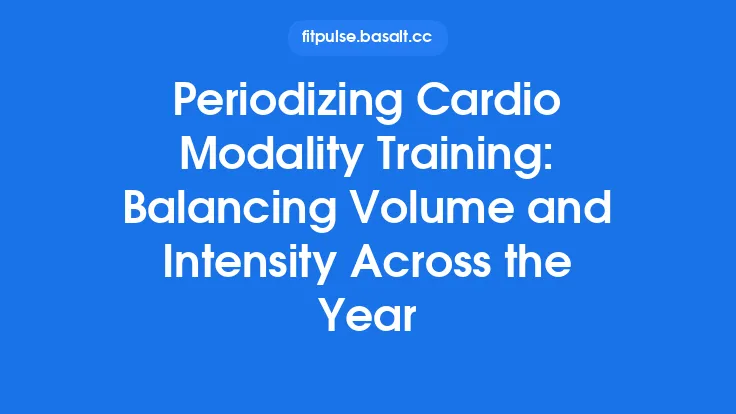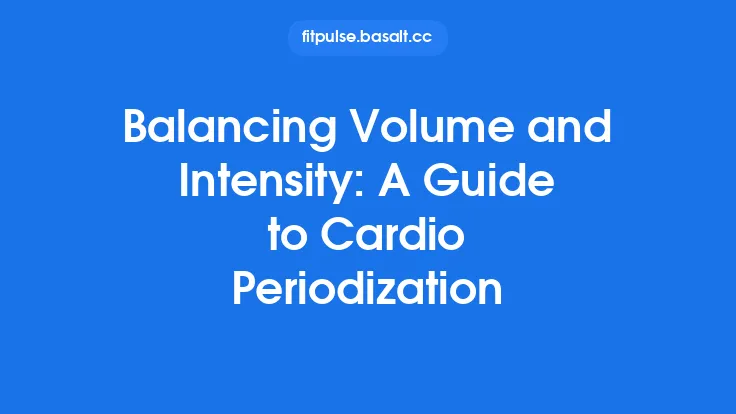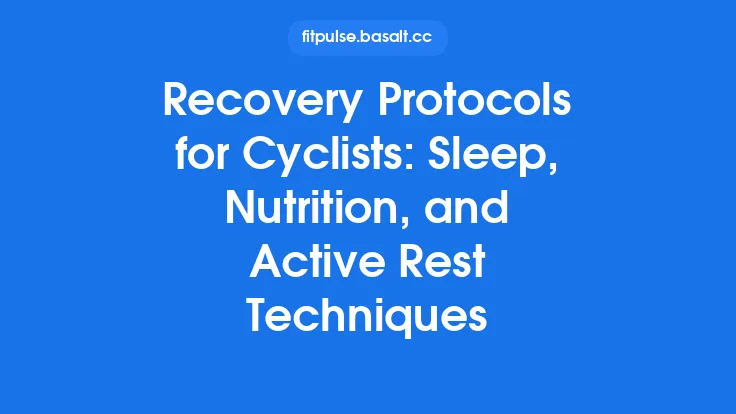Endurance athletes constantly walk a fine line between pushing the limits of performance and preserving the body’s capacity to adapt. While the hard‑training days build the physiological foundation for speed and stamina, the days in‑between are equally critical for translating that stress into lasting gains. Active recovery—purposeful, low‑stress movement performed after demanding sessions—offers a strategic bridge between heavy workloads and full rest. When applied thoughtfully, it helps clear metabolic by‑products, re‑engage neuromuscular pathways, and maintain a level of circulatory activity that supports tissue repair without adding appreciable training load. The key to unlocking these benefits lies in balancing the volume (how much you do) and the intensity (how hard you push) of the recovery work itself. Below, we explore the science behind that balance and provide a practical framework for endurance athletes seeking to fine‑tune their recovery toolbox.
Understanding the Physiological Landscape of Endurance Fatigue
Endurance training taxes several interconnected systems:
- Energy‑system depletion – Prolonged efforts drain muscle glycogen, elevate intramuscular lactate, and increase reliance on oxidative phosphorylation.
- Oxidative stress – Reactive oxygen species accumulate, challenging cellular membranes and signaling pathways.
- Muscle‑protein turnover – Micro‑trauma to contractile fibers triggers repair processes that require amino acids and a favorable hormonal environment.
- Central fatigue – Neurotransmitter fluctuations and elevated brain temperature can diminish motivation and perceived effort.
These stressors do not resolve instantly. The body needs a window of reduced load to replenish glycogen, clear metabolites, restore redox balance, and rebuild protein structures. Active recovery, when calibrated correctly, accelerates each of these processes by sustaining gentle blood flow and modest neural activation.
The Role of Volume and Intensity in Training Stress
- Volume refers to the cumulative amount of work—distance covered, minutes spent, or total repetitions performed. In endurance sports, volume is the primary driver of aerobic adaptations.
- Intensity denotes the relative effort level—pace, power output, or perceived exertion—required to sustain the work. Intensity shapes lactate threshold, VO₂max, and neuromuscular efficiency.
When combined, volume and intensity generate the overall training load. A high‑volume, low‑intensity block builds endurance capacity, while a high‑intensity, low‑volume block sharpens speed and power. However, the same principles apply to recovery: too much volume or too high an intensity on a recovery day can inadvertently add to the training load, blunting the intended restorative effect.
Why Active Recovery Is Not Just “Easy” Exercise
Active recovery is often mistaken for a leisurely jog or a casual bike ride, but its purpose extends beyond simply moving the legs:
- Enhanced microcirculation – Light rhythmic movement promotes capillary perfusion, delivering oxygen and nutrients while flushing out lactate and other metabolites.
- Neuromuscular re‑activation – Gentle joint excursions keep motor units firing at a low frequency, preserving proprioceptive acuity and preventing the “de‑conditioning” that can follow complete inactivity.
- Hormonal modulation – Low‑stress activity can attenuate cortisol spikes and stimulate modest increases in anabolic hormones such as growth hormone, supporting tissue repair.
- Psychological transition – Engaging in purposeful movement helps athletes shift from a competitive mindset to a recovery mindset, reducing mental fatigue.
The effectiveness of active recovery hinges on keeping the stimulus below the threshold that would trigger additional adaptation signals. This is where the balance of volume and intensity becomes critical.
Designing Volume‑Sensitive Active Recovery Sessions
1. Quantify the preceding load
- Review the total distance, duration, and any notable spikes in effort from the previous training day.
- Identify the dominant stressor (e.g., a long tempo run vs. a hill repeat session).
2. Determine the “recovery dose”
- For a high‑volume day, aim for a recovery volume that is roughly 20‑30 % of the previous session’s distance or time.
- For a high‑intensity day, keep the recovery volume even lower—often 10‑15 %—to avoid compounding metabolic stress.
3. Choose a modality that aligns with the recovery dose
- If the prior session emphasized long, steady effort, a similarly rhythmic but shorter activity (e.g., a 15‑minute easy paddle on a rowing machine) can match the movement pattern without overloading the system.
- After a session heavy on leg power, a low‑impact upper‑body focused activity (e.g., a light kettlebell swing circuit with minimal load) can provide circulation without taxing the already fatigued lower limbs.
4. Monitor acute feedback
- Pay attention to breathing rate, muscle tightness, and overall sense of ease during the recovery bout. The activity should feel “comfortable” and not provoke a noticeable increase in perceived strain.
Intensity Modulation Without Traditional Metrics
While heart‑rate zones and formal perceived‑effort scales are common tools, athletes can gauge intensity through more intuitive cues:
- Breathing pattern – Recovery work should allow you to maintain a conversation without gasping. If speech becomes labored, the intensity is likely too high.
- Muscle tension – Muscles should feel lightly engaged, not burning or trembling. A gentle “pump” is acceptable, but sharp fatigue signals excess load.
- Sweat rate – Light perspiration is typical; profuse sweating suggests a higher metabolic demand than intended.
By anchoring intensity to these physiological sensations, athletes can keep the effort comfortably below the point where lactate accumulation or significant sympathetic activation occurs.
Integrating Non‑Cardiovascular Active Recovery Modalities
Active recovery does not have to be limited to locomotor activity. Complementary techniques can enhance circulation and tissue health while keeping systemic load minimal:
- Self‑myofascial release (foam rolling, massage balls) – Applying moderate pressure along muscle fibers promotes fascial glide and improves local blood flow.
- Contrast water immersion – Alternating brief periods of warm (≈38 °C) and cool (≈15 °C) water exposure creates a vascular “pump” that accelerates metabolite clearance.
- Compression garments – Graduated compression on the limbs can augment venous return, reducing swelling and perceived soreness.
- Proprioceptive balance drills – Simple single‑leg stands on an unstable surface (e.g., a balance pad) stimulate joint receptors without imposing significant metabolic stress.
- Gentle mobility work – Static holds for major joints (hip flexors, thoracic spine) maintain range of motion without the dynamic stretch component.
These modalities can be sequenced before, during, or after a brief movement‑based recovery bout, creating a holistic low‑stress session.
Nutritional Strategies to Complement Active Recovery
Recovery is a multi‑system process, and nutrition is the substrate that fuels it:
- Carbohydrate timing – Consuming 0.8‑1.2 g·kg⁻¹ of carbohydrate within the first hour post‑exercise replenishes glycogen stores more efficiently, especially when paired with the modest insulin response triggered by light activity.
- Protein provision – 20‑25 g of high‑quality protein (≈0.25 g·kg⁻¹) within the same window supplies essential amino acids for muscle‑protein synthesis, supporting repair without excessive caloric load.
- Electrolyte balance – Sodium, potassium, and magnesium replacement helps maintain fluid distribution and neuromuscular function, particularly after sweat‑heavy sessions.
- Anti‑inflammatory foods – Incorporating omega‑3‑rich sources (e.g., fatty fish, chia seeds) and polyphenol‑dense fruits (berries, tart cherries) can blunt the inflammatory cascade that follows prolonged endurance work.
When paired with an appropriately dosed active recovery session, these nutritional tactics accelerate the transition from catabolism to anabolism.
Sleep and Circadian Considerations for Endurance Recovery
Even the most meticulously planned active recovery day can be undermined by inadequate sleep:
- Quantity – Aim for 7‑9 hours of consolidated sleep per night; endurance athletes often benefit from the upper end of this range.
- Quality – Minimize sleep disruptions by establishing a consistent pre‑bed routine, limiting screen exposure, and maintaining a cool, dark environment.
- Timing – Align training and recovery sessions with natural circadian peaks (late afternoon to early evening) when core temperature and muscle strength are highest, then allow a wind‑down period before sleep.
- Naps – Short (20‑30 minute) naps can replenish alertness and aid glycogen restoration without interfering with nighttime sleep architecture.
Optimizing sleep synergizes with active recovery, ensuring that the physiological “reset” occurs both on‑ and off‑the‑field.
Psychological and Cognitive Aspects of Active Recovery
Mental fatigue can be as limiting as physical fatigue. Incorporating low‑stress mental practices during recovery days can enhance overall readiness:
- Breathing awareness – Slow diaphragmatic breathing (4‑6 breaths per minute) activates the parasympathetic nervous system, lowering heart‑rate variability and promoting relaxation.
- Visualization – Mentally rehearsing race strategies or technique cues while performing gentle movement reinforces neural pathways without physical strain.
- Mindful movement – Focusing attention on the sensation of each joint’s range during a light activity cultivates body awareness and reduces stress hormones.
These practices not only improve recovery quality but also sharpen the athlete’s mental edge for upcoming training sessions.
Practical Framework for Balancing Volume and Intensity in Active Recovery
- Assess the prior session – Identify the dominant stressor (volume vs. intensity) and quantify total work.
- Set a recovery volume target – Use the 10‑30 % rule based on the previous day’s load.
- Select a low‑impact modality – Choose an activity that mirrors the movement pattern without overloading the same muscle groups.
- Gauge intensity via physiological cues – Keep breathing conversational, muscle tension light, and sweat modest.
- Incorporate complementary non‑cardiovascular tools – Add foam rolling, contrast immersion, or compression as needed.
- Fuel appropriately – Provide carbs and protein within the first hour, hydrate, and consider anti‑inflammatory foods.
- Prioritize sleep – Ensure adequate nighttime rest and, if needed, a brief nap.
- Add a mental component – Include breathing or visualization to complete the recovery package.
- Review and adjust – After the next training session, note any lingering soreness or performance dips and fine‑tune the recovery dose accordingly.
By iterating through this loop each week, endurance athletes can systematically calibrate their active recovery, ensuring that volume and intensity remain in harmony with the broader training plan.
Balancing the amount and the effort of active recovery is not a one‑size‑fits‑all prescription; it is a dynamic process that responds to the ebb and flow of training stress. When athletes respect the delicate interplay between volume and intensity—using physiological cues, targeted modalities, and supportive nutrition and sleep—they transform recovery from a passive afterthought into a potent catalyst for performance gains. In the long run, this nuanced approach safeguards health, prolongs athletic longevity, and keeps the athlete consistently moving forward on the path to endurance excellence.





